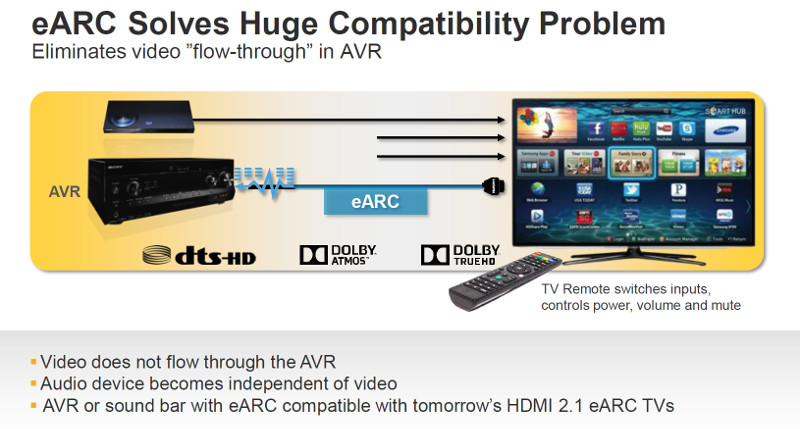The new HDMI 2.1 specification includes an improved audio return channel as part of the specification. Not only does it increase bandwidth, but it addresses connectivity issues when routing audio through an AVR, multiple remote concerns, and offers much better brand interoperability compared to the previous ARC technology included in older HDMI specifications.
The connectors and pin lay-out for HDMI 2.1 remains the same, but eARC re-appropriates the two pins devoted to Ethernet over HDMI (pins 14 and 19 plus the ground on pin 17). This allows the data rate to increase from 1 Mbps with ARC to 37 Mbps with eARC.

The discovery methods also changes from CEC to discovery over the eARC data channel. CEC was not universally implemented so it led to inconsistent discovery of the audio capabilities of AVRs, TVs and outboard audio devices like soundbars. This should be eliminated with eARC as it interrogates the audio devices EDID data to find out its capabilities (just as video capabilities can be determined with the EDID data). This is a great improvement over the old TOSLINK and SPDIF audio outputs, which require a separate cable and connector, and lack the ability to communicate back to the the audio device and TV.
Perhaps the biggest problem eARC addresses is the loss of signal when routing audio and video through an AVR device. For example, if you buy a new 4K Blu-ray player and 4K TV but want to use your existing AVR and speaker system, you may have a problem. If the Blu-ray player has two HDMI outputs, one can be routed to the AVR and one to the TV, which solves the problem.
However, according to Marshall Goldberg, marketing manager at Lattice Semiconductor, many Blu-ray players only have one HDMI output and when routed through the AVR there is a high chance of signal loss unless it is a very new AVR. Routing video through the AVR is challenging for the AVR makers as there are so many formats to support with constant updates – and consumers don’t upgrade that often.
eARC address this issue by connecting the Blu-ray player to the TV and the TV to the AVR. With the new eARC data channel, the Blu-ray player can read the EDID of the AVR and route the audio thru the TV to the AVR. “We think that eARC will future proof your audio set up for 20 years,” said Goldberg.

Another cool feature of eARC is “heartbeat monitoring.” This means the AVR or soundbar sends a pulse every second or so to confirm it is receiving and playing audio. If the TV loses the heartbeat, it automatically switches on the TV speakers.
A single remote can also be used to control power and audio, so long as these connected devices implement CEC control.
To implement eARC you need new audio transmit/receive chips (Rx Sil9437 and TX Sil9438). These are small 4x4mm devices, however. If these chips are not present, the system defaults back to ARC. Marshall expects audio devices with these chips to be shown at CES 2018 ahead of HDMI 2.1 silicon with full video support. – CC


